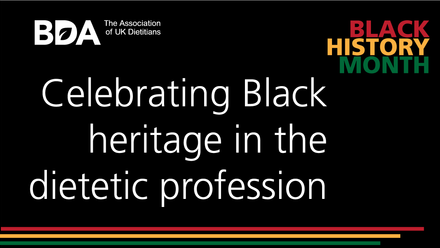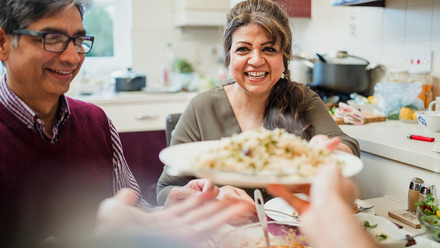Healthy eating is about having a wide variety of foods and nutrients in your diet and consuming the right amount of food and drinks to support your overall health and wellbeing.
Despite what is seen in the media, in some magazines, books and TV, healthy eating is not about dieting. Eating well doesn’t mean you have to give up on your cultural or favourite foods. It is about enjoying these in moderation and as part of a healthy, balanced diet.
Healthy benefits of eating well
Most individuals of African and Caribbean descent living in the UK have a higher risk of long-term health conditions such as type 2 diabetes, stroke, some heart and circulatory diseases. Though there are many factors that contribute to the development of some of these conditions, a healthy diet that is low in saturated fat and salt, high in fruits, vegetables and wholegrains can play an important role in the prevention and management of them.
Having said this, a well-balanced diet has other health benefits such as maintaining a healthy body weight, supporting the normal functioning of the immune system, preserving good bone health and improving digestive health too.
Food groups in our diet
There are five main food groups: fruit and vegetables, starchy carbohydrates, protein, dairy (and dairy alternatives) and oils and spreads.
The Eatwell Guide shows how much of what you eat overall should come from each food group. The aim isn’t to achieve this balance with every meal, but to try to get the balance right over a day or even a week.
Fruit and vegetables - are you getting your 5 a day?
Fruit and vegetables are a good source of vitamins, minerals and dietary fibre, which are all important for general health. It is recommended to eat at least five portions of a variety of fruit and vegetables. One portion is 80g which is roughly the amount that fits into the palm of your hand.
The BDA's fact sheet on fruit and vegetables provides more information and examples of what a portion looks like.
Studies have shown that people who eat a lot of fruits and vegetables have a lower risk of developing heart disease, stroke, obesity, type 2 diabetes and some cancers (including bowel cancer). Most people are not meeting their five portions a day recommendation.Data from health surveys has shown that the percentage of Black adults in England meeting their 5 a day is the lowest amongst all ethnic groups.
There are some ways to increase fruit and vegetable intake to give your body the nutrients it needs to support your long-term health such as:
- Opting for canned and frozen fruits and vegetables as cheaper, convenient and stay fresher for longer than fresh fruits
- Choosing different colours of fruit and vegetables like jackfruit, breadfruit, ackee, okra, sweetcorns, spinach, callaloo, cabbage, plum tomatoes, bell peppers, eggplant, mangos, pineapples, berries and bananas
- Topping breakfast cereals, cornmeal porridge, oatmeal or yoghurt with fruits
- Adding a variety of vegetables to rice dishes, soups, stews and curries
- Having a salad or steamed vegetables with your main meal
Starchy carbohydrates
Starchy carbohydrates should make up just over a third of the food you eat, and you should try to base your meals on these foods. Starchy carbohydrates are a good source of energy and a range of nutrients like calcium, iron and B vitamins. Wholegrain varieties are a good source of fibre which can be beneficial to your digestive system, help stabilise blood sugar levels and lower cholesterol levels too.
Some healthy ways to include carbohydrates in your diet include:
- Trying to have basmati rice, brown rice, wild rice, ofada rice or bulgar wheat. These are high in fibre, which helps to keep your digestive system working well
- Consider having wholemeal bread varieties like wholemeal pitta bread, hard-dough bread and flatbread
- Consider having boiled or baked yam instead of fried yam
- Be mindful of the portion size of eba, pounded yam, ugali, banku, fufu or plakali. As a general guide, aim for a fist size serving when it comes to these types of starchy carbohydrates. Additionally, try to have more stew or soups instead and bulk it up with vegetables or pulses
- Bake or grill plantain rather than frying. If you decide to fry, use a kitchen roll to remove excess oil or use an air-fryer
- Leave the skin on potatoes to boost your fibre intake
Beans, pulses, fish, eggs, meat and other protein
These foods are good sources of protein, which is important for the body to grow and repair itself. They also contain vitamins and minerals including iron, zinc and B vitamins.
Red meat (like beef, goat, lamb and pork) is a great source of these nutrients, but it is important to consume these in moderation. Current recommendation is to eat no more than about three portions a week, which is around 350g cooked weight a week. It is also beneficial to reduce intake of processed meats like bacon, ham and salami in the diet. Regular consumption of these has been linked to higher risk of bowel cancer.
If you eat fish, try to aim for at least two portions of fish every week, one of which should be oily (e.g. salmon, mackerel, sardines and pilchards). Oily fish is also a source of omega 3 fatty acids which has heart-protective benefits and vitamin D, which helps to keep bones and teeth healthy as well as support immune function. Black African and Caribbean adults living in the UK are at a high risk of vitamin D deficiency. Including vitamin D rich foods like oily fish in the diet as well as taking a daily supplement containing 10 micrograms (mcg) all year round may help to ensure adequate vitamin D levels.
Other nutrition tips to consider when it comes to adding protein sources to your diet include:
- Opting for plant-based protein sources like beans and pulses, such as red kidney beans, black-eyed peas, gungo peas, chickpeas, lentils, in main dishes, stews or curries to replace some (or all) of the meat
- Adding nuts or seeds like egusi or melon seeds to your stews & soups
- Cutting off any visible fat and skin from meat before cooking
- Grilling chicken or fish instead of frying
Milk and dairy foods
These are great sources of protein, minerals and vitamins like potassium, phosphorus, iodine and calcium. Together, these nutrients can help keep your muscles, bones and teeth healthy. They also help to maintain healthy blood pressure and support the immune system.
Try to aim for three portions of dairy foods or fortified dairy alternatives every day. Go for lower fat and lower sugar options to keep choices balanced. Examples of an adult portion size include:
- 1 small glass (200ml) of semi-skimmed milk
- 1 small pot (150g) of plain low-fat yoghurt
- 1 small matchbox-sized piece (30g) of low-fat cheese
Other ways to boost your dairy or alternative intake:
- Try to go for low-fat coconut milk to add to rice dishes
- Make hot milky drinks whilst being aware of sugar content
- Use milk in breakfast cereals, porridges or ogi/pap
Some people might use evaporated or condensed milk in cereals, porridges or in hot beverages. These have more calories, fat and sugar than regular whole milk. Where possible, opt for light options as a healthier option or go for semi-skimmed, skimmed milk or calcium- and iodine-fortified plant-based milks instead.
Oils and spreads
We all need fats in our diet. They provide us with energy, some essential vitamins and essential fatty acids that the body cannot make by itself.
However, it is important to try to keep an eye out for the type of fat that’s in the oil or spread you use. Eating too much food high in saturated fat can increase the risk of heart disease, whilst food containing unsaturated fat can help reduce your risk. Other fats, such as omega-3 fatty acids may protect against heart disease.
Some nutrition tips to consider in your diet when it comes to oils and spreads:
- Go for unsaturated oils & spreads like rapeseed, olive and sunflower instead of palm oil, coconut oil, ghee and lard (as these contain saturated fat)
- If you want to add palm oil or coconut oil, try measuring a very small amount of oil instead of free pouring
- Some people may go for palm oil as it can be used for cooking at high temperatures without burning. But oils like rapeseed and olive oil (not virgin or extra virgin) can be used to cook at high temperatures too
- All types of oils are high in energy and add fat to your diet. It might be worth considering boiling, baking, steaming, air-frying or grilling foods instead of frying using oil
Limit intake of foods high in fat, salt & sugar (HFSS)
Limiting doesn’t mean you have to totally restrict HFSS foods from your diet. You can still enjoy some of these foods in your diet occasionally. Frequently eating too many HFSS food products has been linked to health issues like high blood pressure so eating these less often and in small amounts can help to improve your health.
Some health tips:
- Reduce consumption of malted alcoholic and non-alcoholic drinks, sugary fruit punch and fizzy drinks
- Have snacks like plantain chips or crisps, puff puff (sweet fried dough balls), chin chin (sweet fried dough snacks), vetkoek (fried dough bread), spice bun and festivals (fried dumplings) as a treat, occasionally
- Use fresh herbs & spices like turmeric, coriander, parsley, cayenne pepper, basil, ginger and garlic instead of regular salt or gourmet salt (e.g pink himalayan salt)
- Make your own stock rather than using ready-made stock cubes that are usually very high in salt
- If you want to use stock cubes in cooking, try to choose the low-salt or low-sodium options but still be mindful of how much you use
- Boil vegetables, any meat or fish bones with spices and herbs to make your own stock
- Read nutritional information on food labels to compare food products and select those that are lower in fat, salt and/or sugar
Summary
Making small changes like being more mindful of portion sizes, cooking methods and how often you consume foods that tend to be high in saturated fat, salt and sugar are some ways to ensure that you’re having a well-balanced diet without feeling like you must choose between your culture and health.
This is for information only and not a substitute for proper medical diagnosis or dietary advice given by your Dietitian. If you require tailored dietary advice, please visit your GP for a referral or www.freelancedietitians.org for a private dietitian. To check your dietitian is registered check www.hcpc-uk.org.




